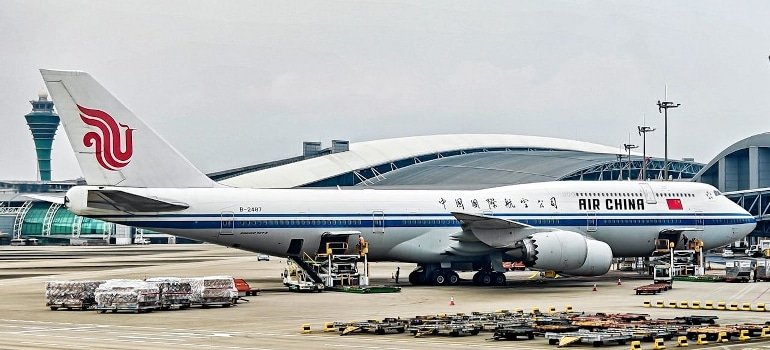How to Ship Lithium Batteries Overseas Safely and Legally

Get a Free Moving Quote Now!
Start Your International Moving Journey





Moving abroad often involves more than furniture and personal belongings. Many families also need to ship lithium batteries overseas for electronics, power tools, or backup systems. The process can feel complex at first glance, but it becomes manageable with the right guidance. International movers handle such shipments daily, proving that compliance and safety go hand in hand with convenience. The key lies in understanding rules, choosing proper carriers, and using correct packaging so your shipment reaches its destination smoothly. Costs vary widely, yet following each regulation closely prevents fines, delays, or rejected cargo. As demand for battery-powered devices grows, so does the need for clear steps that keep shipments safe and legal across borders.
What International Regulations Must You Follow For Lithium Battery Shipping
International shipments require strict compliance with aviation and maritime rules because lithium batteries pose fire risks if mishandled. International household goods movers confirm that the International Air Transport Association (IATA) Dangerous Goods Regulations guide all air shipments worldwide. These rules limit battery watt-hours, packaging methods, and state of charge, while also requiring hazard labels and documentation. For sea freight, the International Maritime Dangerous Goods (IMDG) Code applies similar requirements to prevent accidents during long voyages.

Passenger aircraft face tighter restrictions than cargo planes, so selecting the right carrier matters when speed and cost compete with safety standards. Shipments exceeding quantity limits often need special permits, adding time and expense. Missing paperwork or using non-compliant packaging leads to customs rejection or return at the shipper’s cost, so accuracy saves money and avoids shipment seizures at international ports or airports.
Regulations To Know Before Shipping
Before shipping lithium batteries internationally, it helps to understand the most important rules that keep shipments safe and legal:
- IATA Dangerous Goods Regulations (DGR) for air shipments worldwide
- IMDG Code governing sea freight compliance standards
- UN3480 classification for lithium-ion batteries
- UN3090 classification for lithium-metal batteries
- Packaging Instruction 965 for standalone batteries in air shipments
- Packaging Instruction 968 for standalone batteries in sea shipments
- 30% state-of-charge rule for air transport safety
- Shipper’s Declaration for Dangerous Goods form requirements
- Quantity and watt-hour limits per package and per shipment
- Country-specific restrictions beyond international standards
How Do You Choose Between Air, Sea, And Ground Shipping Options
Families moving abroad often wonder which transport mode best suits their needs when sending batteries. International movers in NYC say air shipping offers speed but comes with higher costs and stricter limits on battery size, quantity, and charge levels. Sea freight handles larger loads at lower prices yet involves longer transit times and complex port handling procedures. Ground shipping applies only when land routes connect origin and destination countries, so most overseas moves rely on air or sea carriers.
Air cargo rates for small shipments under ten kilograms often start around $150 to $250, while sea freight may drop below $200 for similar loads but takes weeks rather than days. Delivery deadlines, route safety records, and destination regulations all influence the choice because some countries impose unique rules on lithium battery imports regardless of shipping method.
What Packaging Rules Apply To Lithium Batteries
Carriers demand specific packaging to prevent short circuits, overheating, or damage during transport because lithium batteries react violently under certain conditions. International movers in NJ say shipments require UN-certified packaging tested for impact resistance, pressure changes, and fire safety standards. Boxes must carry Class 9 hazard labels, orientation arrows, and handling marks so airline or port workers recognize dangerous goods immediately. Strong outer boxes paired with inner cushioning keep batteries stable during turbulence or rough sea conditions.

Fire-resistant liners or insulation materials prevent thermal runaway from spreading if one cell fails mid-transit. Packages exceeding weight or quantity thresholds often need additional overpacks or metal containers approved by regulatory authorities, raising both cost and preparation time. Skipping these steps risks shipment rejection because carriers inspect packaging before accepting dangerous goods at terminals or cargo facilities.
Essential Packaging Requirements To Follow
To ensure safety and compliance, shipments must meet the following packaging standards:
- UN-certified packaging tested for drop, pressure, and fire resistance
- Class 9 hazard labels and handling marks placed on all outer containers
- Strong outer cartons with inner cushioning materials to prevent movement
- Fire-resistant liners or insulation for thermal runaway prevention
- Orientation arrows indicating correct package handling direction
- Overpacks or metal drums for shipments exceeding standard weight limits
- Sealed inner packaging for individual battery protection
- Carriers’ specific performance standards before cargo acceptance
- Documentation matching packaging methods for customs clearance
- Regular inspection before and after packing to avoid rejection risks
Why Does The State Of Charge Matter For Air Shipments
The state of charge rule surprises many families shipping batteries abroad for the first time because it restricts energy levels before transport. Container shipping guidelines and IATA regulations require lithium-ion batteries to remain at or below thirty percent charge when loaded onto aircraft. This limitation reduces fire risk during pressure changes at high altitudes since lower charge levels generate less heat if short circuits occur.
Shippers often discharge batteries beforehand using specialized equipment to meet this requirement because carriers refuse loads exceeding the limit without government exemptions. Testing records proving compliance accompany shipping documents so customs officers and airline staff verify safety measures quickly. Failure to follow this rule delays flights or redirects cargo to slower sea transport where charge limits sometimes differ, affecting delivery schedules and increasing storage fees at ports awaiting regulatory clearance.
How Should You Handle Labeling And Documentation For Battery Shipments
Incorrect paperwork causes many shipping delays because dangerous goods require detailed documentation for every package crossing borders. Packing services for overseas shipping prepare Class 9 hazard labels, UN numbers, and Shipper’s Declarations for Dangerous Goods so each shipment meets international standards. Labels must appear on multiple package sides for visibility during inspections, while documents list battery types, quantities, weights, and packaging methods in technical detail.
Customs agencies match this information against physical cargo before granting clearance at airports or seaports. Errors trigger fines, rejections, or costly storage fees while awaiting corrected paperwork from shippers. Some carriers demand electronic pre-advice forms submitted before arrival so their systems verify compliance ahead of time, reducing terminal handling delays and avoiding missed flights or vessel departures due to incomplete documentation records.
Labeling And Documentation Steps
For smooth shipping and compliance, shippers should follow these documentation steps:
- Apply Class 9 hazard labels on multiple sides of each package for visibility
- Include correct UN numbers for lithium-ion or lithium-metal batteries
- Prepare the Shipper’s Declaration for Dangerous Goods with complete details
- List battery watt-hours, weights, and packaging methods accurately
- Match documentation with physical shipment contents for customs clearance
- Use carrier-specific electronic pre-advice systems when required
- Double-check spelling, numbers, and signatures to prevent rejections
- Provide handling instructions and orientation arrows for safety crews
- Retain copies of all documents for audits or dispute resolution
- Submit paperwork early to avoid flight or vessel departure delays
What Are The Limits On Battery Quantity And Watt-Hours
Governments restrict total lithium content per cell and watt-hours per battery to limit fire risks in transport environments where firefighting options remain limited. International moving costs can increase if you exceed thresholds requiring special permits or packaging beyond standard regulations. Passenger aircraft typically allow smaller batteries under one hundred watt-hours each, while cargo planes handle larger units if quantities stay within prescribed limits per package.
Sea shipments permit heavier loads, yet demand metal drums or reinforced containers once quantities surpass certain tonnage cutoffs set by maritime authorities worldwide. Families sending multiple devices often split shipments across packages so each meets weight, quantity, and energy restrictions without triggering special handling fees or longer approval processes that raise costs and extend delivery timelines unnecessarily across international routes connecting multiple regulatory jurisdictions.
How Do Carrier And Country Rules Affect Lithium Battery Shipping
Carriers and destination countries impose unique restrictions beyond international guidelines because local safety laws sometimes exceed global standards. Moving to Europe from USA routes face European Union regulations requiring additional recycling documentation for certain battery chemistries, while Asian destinations may cap total shipment weights below IATA limits. FedEx demands pre-approval for international lithium battery shipments, UPS enforces strict packaging performance tests, and DHL requires advance notification when loads exceed standard risk categories before accepting cargo at terminals.

Some countries inspect hazardous goods at both entry and exit points, delaying transit times if paperwork or packaging appears inconsistent with national import controls. Families that plan to ship lithium batteries overseas must confirm destination requirements beforehand because assuming global uniformity leads to surprises during customs inspections across diverse legal environments governing hazardous materials transport worldwide.
How Much Does It Cost To Ship Lithium Batteries Overseas
Costs vary widely depending on shipment weight, distance, carrier, and regulatory complexity because hazardous materials handling incurs additional fees beyond normal cargo rates. International movers report hazardous materials surcharges often range from forty-five to seventy dollars per shipment, while small airfreight loads under ten kilograms typically cost one hundred fifty to two hundred fifty dollars door-to-door. Sea freight prices start near one hundred dollars for similar weights but climb above five hundred dollars for larger consolidated loads requiring port storage, customs brokerage, and inland delivery arrangements abroad.
Packaging expenses add another fifty to one hundred dollars when UN-certified boxes, hazard labels, and cushioning materials become mandatory under carrier rules. Insurance premiums rise with declared shipment value since carriers limit liability for dangerous goods unless shippers purchase supplemental coverage against loss, theft, or accident risks during international transit stages across multiple jurisdictions.
Why Is Insurance And Risk Management Important For These Shipments
Lithium batteries present fire hazards if damaged, short-circuited, or exposed to extreme temperatures during transport, so risk management remains essential for safety and financial protection. When you ship lithium batteries overseas, use cargo insurance because standard carrier liability often excludes hazardous materials once shipments leave origin terminals. Policies covering dangerous goods cost more yet prevent catastrophic losses if fires, accidents, or regulatory seizures destroy cargo mid-transit. Thermal runaway incidents aboard aircraft or vessels trigger investigations, fines, and civil liabilities exceeding shipment value when insurance remains absent or inadequate.
Risk mitigation also involves choosing carriers with proven hazardous goods handling records, temperature-controlled storage options, and real-time tracking systems for early incident detection. Families shipping expensive battery-powered equipment abroad gain peace of mind when financial safeguards complement packaging, labeling, and documentation practices meeting every legal and safety standard enforced internationally today.
What Common Mistakes Should You Avoid When Shipping Batteries Abroad
Avoiding preventable errors saves families time, money, and frustration when sending batteries overseas because carriers and regulators reject non-compliant shipments instantly. International movers warn against using damaged or secondhand packaging lacking UN certification stamps since inspectors refuse such containers at airports or ports. Missing hazard labels, incorrect watt-hour markings, or incomplete Shipper’s Declarations delay clearance until corrected paperwork arrives from origin points, sometimes after flights depart or vessels sail.

Exceeding weight or quantity limits without required permits triggers additional inspections, storage fees, or cargo returns at shipper expense. Failing to discharge batteries below thirty percent charge for air shipments remains another frequent violation grounding loads until compliance testing confirms acceptable energy levels. Careful preparation, carrier coordination, and regulatory knowledge prevent costly setbacks affecting delivery schedules and moving budgets alike.
How To Ship Lithium Batteries Overseas Without Stress
Families planning to ship lithium batteries overseas can stay compliant, safe, and cost-effective by following international rules. International regulations might feel strict, yet they exist to protect lives, property, and the environment from fire hazards. Working with international movers experienced in hazardous goods ensures accurate paperwork, correct labeling, and carrier compliance. This way, shipments move smoothly across borders. Costs drop when packaging meets UN standards, batteries stay below charge limits, and carriers receive complete documentation. With preparation, shipping batteries can be legally done without delays, unexpected fees, or regulatory penalties.
